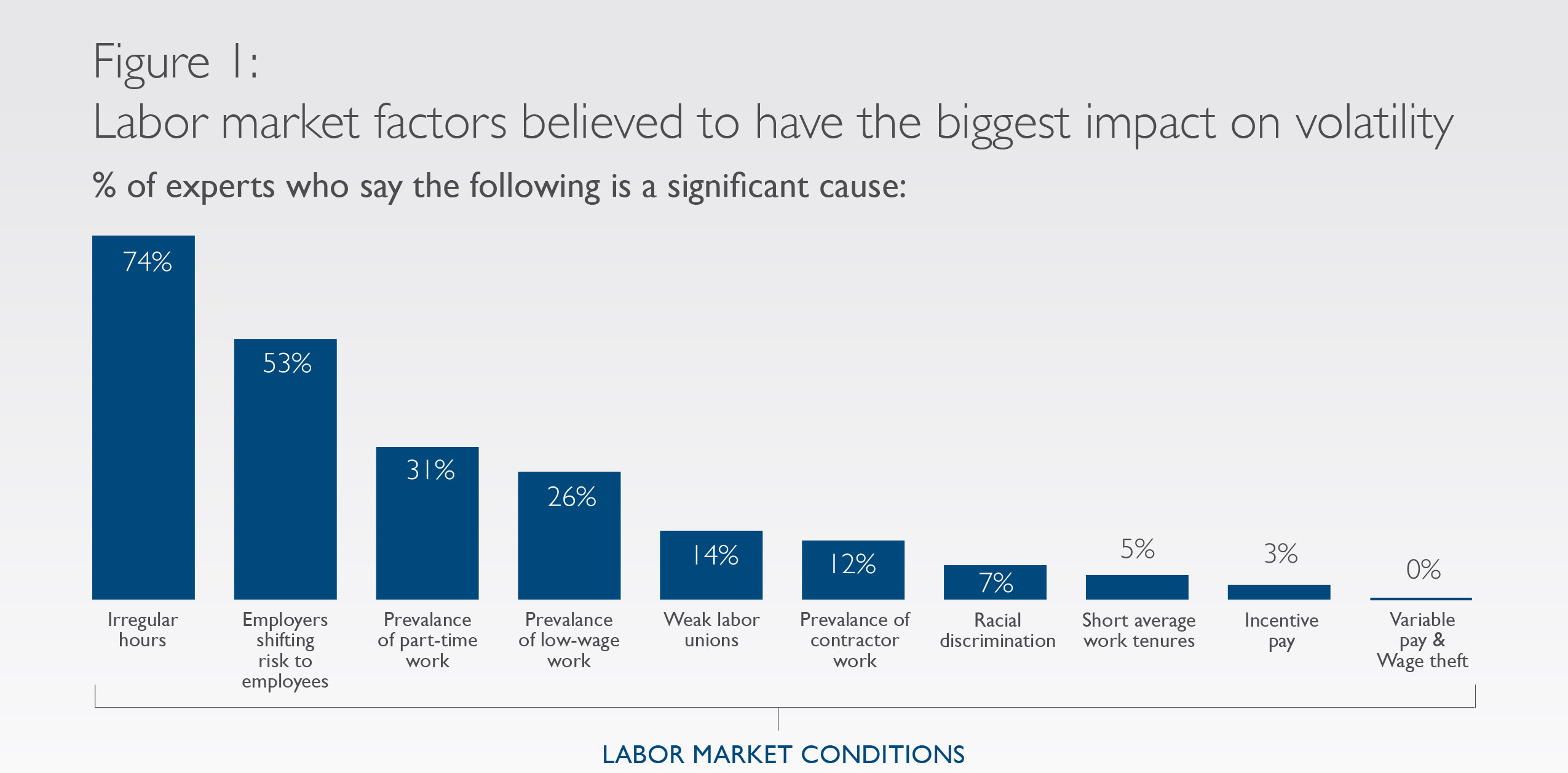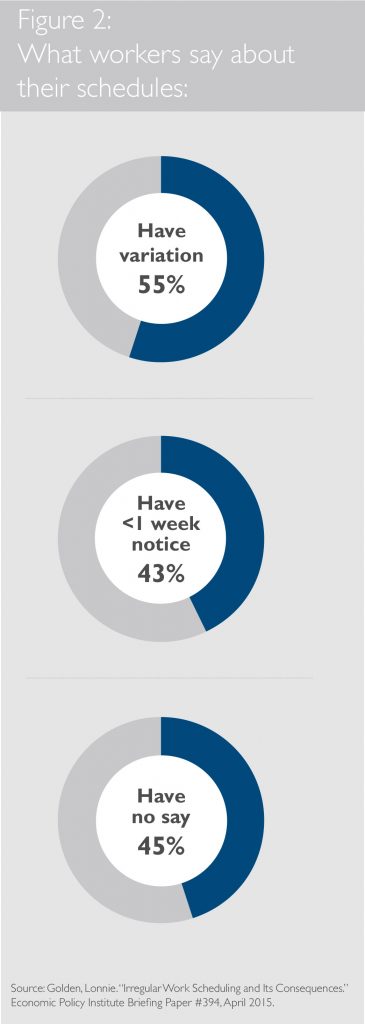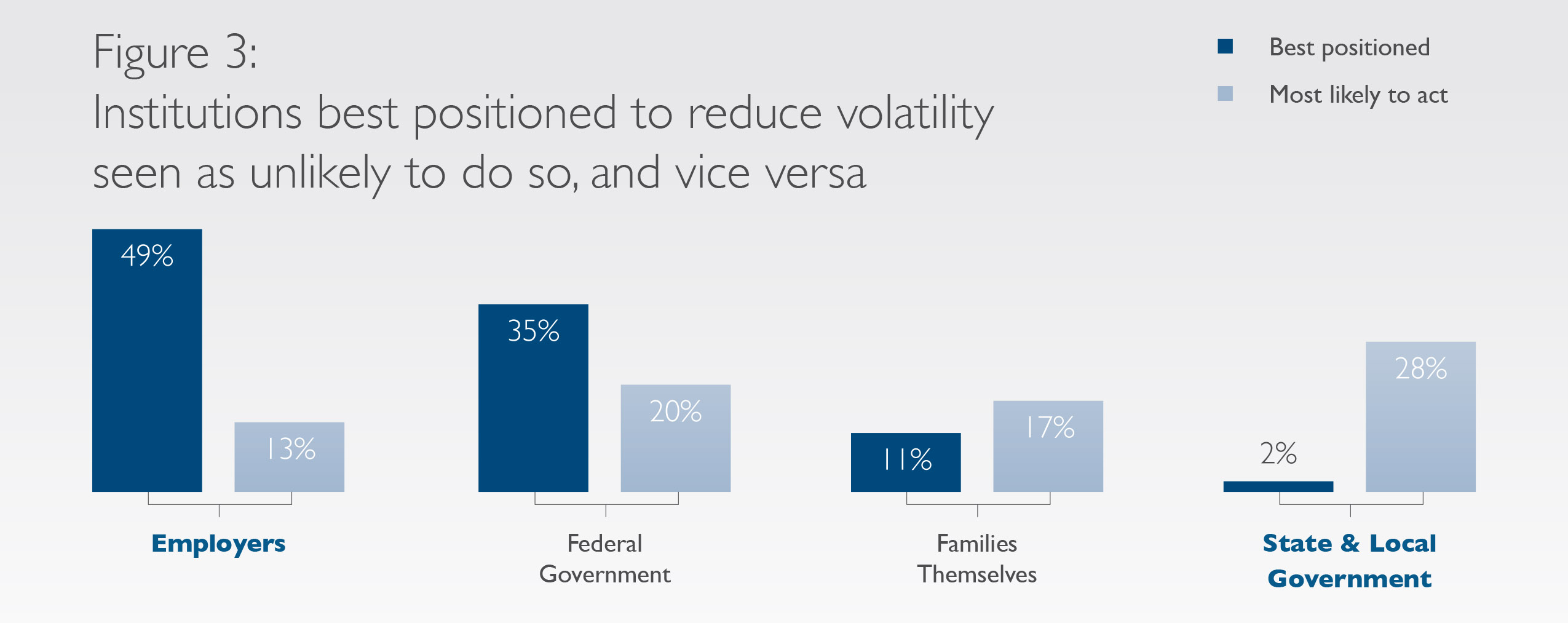●●●●
● Summary
EPIC has identified unpredictable and unstable worker schedules as a major driver of income volatility and believes there is a growing consensus that reforms are needed. This brief synthesizes the current research on scheduling instability, chronicles the most promising responses by the institutions best positioned to act – employers, government, and technology companies – and recommends principles for further reform.
● Background
The Expanding Prosperity Impact Collaborative (EPIC), an initiative of the Aspen Institute’s Financial Security Program, is a first-of-its-kind, cross-sector effort to shine a light on economic forces that severely impact the financial security of millions of Americans. EPIC deeply investigates one consequential consumer finance issue at a time.
EPIC’s first issue is income volatility, which destabilizes the budgets of nearly half of American households. Over the last year, EPIC has synthesized data, polled consumers, surveyed experts, published reports, and convened leaders, all in an effort to build a more accurate understanding of how income volatility impacts low- and moderate-income families and how best to combat the most destabilizing dimensions of the problem.
This brief on scheduling predictability is the first in a series that will explore highly promising solutions to income volatility. Our hope is that this brief will support public and private leaders as they attempt to innovate, implement, and scale solutions to scheduling instability and the income volatility it causes.
● Issue Brief
THE LINK BETWEEN SCHEDULE VOLATILITY AND INCOME VOLATILITY
While research on month-to-month income volatility is still emerging, a number of indicators point to scheduling instability – fluctuations in hours worked – as one of the key drivers of this phenomenon:
- Of those who self-reported volatile monthly incomes in a recent survey, 40% blamed an irregular work schedule for the swings.
- An analysis of banking records found that, for nearly one in four jobs, paycheck amounts varied by more than 30% paycheck to paycheck. This within-job variation in pay explains 86% of the month to month variation in labor income.
- Between 1971 and 2008, annual variability in hours worked has risen hand-in-hand with – and helps explain – the rise in income volatility.
- Week-to-week variation in hours and working a variable or rotating schedule are significantly related to higher income volatility.
- Three-quarters of EPIC’s panel of experts identified irregular hours as one of the three most significant causes of income volatility, by far the most popular choice (see Figure 1).
THE GROWING USE OF ON-DEMAND SCHEDULING
– DRIVING VARIABILITY, UNPREDICTABILITY, AND INADEQUACY
Today’s workers, particularly hourly workers on the lower end of the income spectrum, face three main scheduling challenges: variability, unpredictability, and inadequacy:
- Variability. More and more, employers have the technology and know-how to assign worker hours based on anticipated swings in customer demand, especially in the retail sector. This means that, instead of a consistent 40-hour workweek, employees are often overworked during busy days and weeks, and told not to come in at all during slow periods.Variability is also a major characteristic of seasonal employment and “gig economy” jobs. And even if the number of hours assigned each week remains consistent, there is often variability in when those hours fall during the week. This makes finding high-quality child- or elder-care, holding a second job, or attending school part-time very difficult.

According to one poll, 55% of working adults said the number of hours they worked varied from week to week (Figure 2). The numbers tend to be higher for low-income and hourly workers. For example, three in four early-career workers in hourly jobs report at least some fluctuation in their weekly hours from one month to the next, varying on average by 49%.
number of hours they worked varied from week to week (Figure 2). The numbers tend to be higher for low-income and hourly workers. For example, three in four early-career workers in hourly jobs report at least some fluctuation in their weekly hours from one month to the next, varying on average by 49%.
- Unpredictability. Not only do shift assignments fluctuate, they do so in unpredictable ways and with little advance notice. Sometimes, employers will require workers to “call in” hours before a shift to see if they’re needed. Nineteen percent of workers report usually knowing their schedule a day or less in advance, with a total of 43% often having less than one-week advance notice (Figure 2).
- Inadequacy. Millions of American workers are involuntarily parttime, meaning they would like more hours but don’t get them. Parttimers not only earn less, they also often face the most variability and unpredictability in their schedules. Involuntary part-time work is also indicative of another problem with the current scheduling system: lack of worker input. Forty-five percent of workers report having no say in their schedule (Figure 2). And while some employees surely crave the flexibility of part-time work or are fine with employers setting their schedule, research indicates that in fact the average worker is willing to take a 20% pay cut just to avoid a schedule set by an employer on a week’s notice.
HOW SCHEDULING AND INCOME VARIABILITY HURT FAMILIES AND THE ECONOMY AS A WHOLE
EPIC has already identified a number of negative impacts associated with income volatility, but scheduling variability both causes and compounds these negative effects:
- Those with unstable and unpredictable work schedules are less likely to report being happy, more likely to report trouble sleeping, more likely to experience parental stress, and more likely to be in psychological distress.
- Hourly workers who receive their schedules less than one week in advance are more likely to be in poor or fair health than workers with more notice.
- Employees with irregular schedules are more likely to experience work stress and work family conflict.
- Parents with unstable schedules often struggle to find child care, and children often suffer as a result, receiving care of inconsistent quality.
- These work-life balance challenges may help explain declining labor market participation, especially among women.
HOW INSTITUTIONS CAN HELP: EXISTING APPROACHES
Many employers, governments, and technology companies have identified scheduling instability – and the income volatility it creates – as problems in need of fixing. Innovators in these sectors are pioneering solutions that may offer a scalable pathway forward.
EMPLOYERS
Roughly half of the issue experts EPIC polled believe employers are the best positioned institution to help families reduce their income volatility. However, only 13% believe employers are the most likely to act, potentially because they face the least market and political pressure to change (Figure 3). But some employers have shown a willingness to experiment with new approaches:
- Belk – In 2013, this family-owned department store implemented a workforce management tool to increase sales productivity. By allowing store managers to override the system as necessary, Belk learned about local working conditions and incorporated that information back into the automated system. Its scheduling system has been held up by some as an example of a fair approach that balances worker and firm preferences, and was featured as a Harvard Business Review case study.

- Macy’s – In reaction to labor union pressure, the department store now builds its workers’ schedules about two-weeks in advance and guarantees a certain minimum number of hours each week.
- Walmart – The retail giant, which has 1.5 million employees nationwide, is currently experimenting with a new scheduling system in about 700 of its 4,600 stores. Every worker gets at least three weeks of advance notice, and some receive a fixed six-month schedule.
The full business impact of these innovations is not yet clear, but there is evidence that investing in improving the quality of low-wage jobs can improve morale, reduce turnover, and be good for a company’s bottom line. In fact, some research shows that, in their zeal to reduce labor costs, some large retail chains have found themselves chronically understaffed, which reduces store profitability much more than overstaffing does.
GOVERNMENT
The underlying structure of U.S. labor law, governed by the Fair Labor Standards Act (FLSA), has remained the same for nearly 80 years. As a result, the FLSA does not protect against the newer threats facing workers, including unstable scheduling. There are a number of ways that the federal government – and states or localities, if the federal government does not act – can step in to regulate these practices:
- Right to request: guarantees workers the ability – free from retaliation – to request a schedule that accommodates their unique needs or otherwise allows for flexibility. Employers have to respond in good faith, though different jurisdictions have different requirements regarding whether and when employers can reject requests. This right exists to some degree in Vermont, New Hampshire, Montana, Oregon, San Francisco, Seattle, Emeryville, and Berkeley. In 2014, President Obama gave this right to all federal government employees.
- Reporting pay or show-up pay: guarantees at least some pay for workers who show up at their assigned shift only to be told that their services are no longer needed. The amount of pay depends on the exact language of the rule, but it is usually somewhere between one to four hours at the workers’ regular hourly rate. This rule is in effect in some form today in California, Connecticut, the District of Columbia, Massachusetts, New Hampshire, New Jersey, New York, Oregon, Puerto Rico, and Rhode Island.
- Call-in or on-call pay: guarantees at least some compensation for workers who must call in the night (in some cases, mere hours) before their shift starts to see if they’re still needed. Some have argued that “calling in” amounts to “showing up” under state reporting pay laws and litigation on the matter is currently pending in the courts. The Attorney General of New York has spearheaded efforts to reduce the use of these “on-call shifts” by sending letters to a number of national retailers.
- Split-shift pay: requires extra pay when workers are required to work non consecutive hours throughout the day. The District of Columbia and California currently have such a rule in place.
- Advance notice: requires employers to post workers’ schedules a certain number of days or weeks in advance, and to give extra “predictability pay” to workers whose schedules have been changed last minute. San Francisco, Emeryville (CA), and Seattle are currently the only jurisdictions that have passed such a rule.
"EPIC’s expert panel believed enhanced labor market regulation – which included predictable scheduling – is the most promising of all possible government interventions, with 31% of polled experts agreeing that it should be society’s first priority, beating out the most popular employer and fintech-based interventions."
- More hours for part-time workers: requires employers to offer existing part-time workers more hours before hiring additional employees. Such a rule is now on the books in San Francisco, San Jose, Seattle, and SeaTac.
Federal legislation has been introduced that would set a floor on most, though not all, of these items. Additionally, legislators in roughly seven cities (Albuquerque, Chicago, Cleveland, Minneapolis, New York City, Portland, and Washington DC) and 14 states (CA, CT, IL, IN, KS, ME, MD, MA, MI, MN, NY, NJ, OR, RI) have proposed one or more of the above reforms.
Of course, government action to promote more predictable worker scheduling faces several important challenges:
- Potential business opposition: employers prize flexibility and face pressure to keep labor costs down, so reformers must be able to address these concerns.
- Unintended consequences: legislators must be careful not to draft rules that will ultimately push employers to hire fewer workers or reclassify their workers as independent contractors.
- Enforcement: like many labor laws, scheduling rules often leave it up to workers to identify violations and bring claims, which can lead to rampant – and un-penalized – violations if regulators are not vigilant.
Despite these challenges, EPIC’s expert panel believed enhanced labor market regulation – which included predictable scheduling – is worth the effort. A plurality of the experts polled (31%) agreed that it is the most promising of all possible government interventions. And they believed this intervention should be society’s first priority – beating out the most popular employer- and fintech based interventions.
TECHNOLOGY COMPANIES
As mentioned above, employers often rely on technology-based workforce management companies to build their workers’ schedules – which is no doubt a complicated task. But there’s no reason that the resulting scheduling platforms must hurt workers. It is possible for algorithms to take employee preferences and requests into account as well as build schedules more than a few days in advance. Some innovative tech firms are proving the point with new scheduling tools:
- Workjam – An add-on to firms’ existing workforce management systems, Workjam’s mobile application creates easy to access, optimized schedules weeks in advance and then allows workers to update their availability and swap shifts as necessary. The company claims that its technology can reduce understaffing and staff turnover.
- Shyft – This mobile app allows employees to seamlessly trade shifts with other workers nearby. It has signed up thousands of workers at stores like Starbucks, McDonald’s, and Old Navy. Unlike Workjam, Shyft serves workers directly and operates outside of stores’ internal workforce management systems, though managers can be prompted to approve swaps.
HOW INSTITUTIONS CAN HELP: PRINCIPLES FOR FUTURE ACTION
Energy around scheduling reform is building in all corners of society. Trailblazing employers, governments, and technology companies are coming at the problem from various angles – and new potential solutions seem to be popping up every day. This is a welcome development; it is unlikely that such a complicated problem can be solved through any one channel, and even the most promising innovations need time to prove their effectiveness. Still, there are a number of principles that reformers in all sectors should keep in mind as they continue to work toward fair and predictable worker scheduling:
- Low-wage workers are busy juggling myriad tasks. Indeed, this is the whole reason unpredictable scheduling is so problematic. Giving them another complicated task that requires anything other than a few swipes on their smart phone is destined to fail. Elegant solutions that may not account for every possible scheduling contingency are superior to intricate, unwieldy ones. The same goes for solutions that demand action from employers. Companies, especially small ones, struggle to comply with complicated regulations, and managers will resist wholesale changes to their workflow.
- Create space for research and evaluation. Many of the ideas emerging in this space have never been tried before, so we don’t yet know if they will work. Researchers should be given a front-row seat to the action so that products and policies can be quickly evaluated and iterated upon. The amount of localized activity in this area provides a great opportunity for natural experiments or other types of evaluations that can inform further experimentation.
- Support and promote voluntary changes in scheduling practices. When EPIC’s expert panel was asked to pick the best possible use of public and private resources in the near-term to address volatility, 64% picked “demonstrating the value of reduced volatility to employers” – by far the most popular choice. Moreover, some of the largest scheduling victories to date have come through changes in large employers’ policies. Some employers have largely altruistic motives, others are convinced of the business case, and others have made changes in response to worker dissatisfaction or bad press. Whatever their reasons, employers can play important leadership roles.
- Think creatively about enforcement. Current scheduling practices and labor enforcement policies make it very difficult to assess whether employers are abiding by the rules, whether self- or government-imposed. But new efforts to use technology to connect workers with each other and with regulators could change this. For example, WorkIt is a new mobile app that allows hourly workers to pose questions to and chat with coworkers and trained peer advisors about workplace policies and rights. WorkerReport uses the same “SeeClickFix” technology employed by many cities’ 311 service to help workers report workplace violations like wage theft, though it could also be outfitted to combat unsanctioned scheduling. One benefit of these technologies is that they can reduce the burden workers face in understanding and protecting their rights and employers’ responsibilities, a key challenge for effective government oversight.
These principles can help inform significant improvements to worker scheduling practices by employers, software vendors, and governments alike. Ultimately, providing workers with more stable, predictable schedules will reduce some of the income volatility that undermines workers’ and their families’ financial security.
For Endnotes and Works Cited, as well as more information on FSP and EPIC, please download the PDF version of this Issue Brief.
● Acknowledgments
● More Resources on Scheduling and Income Volatility
●●●●
●●●●
EPIC is an initiative of the Aspen Institute's Financial Security Program.
CONTACT US:
The Aspen Institute
2300 N Street, NW Suite 700, Washington, DC 20037© The Aspen Institute 2017—All Rights Reserved





